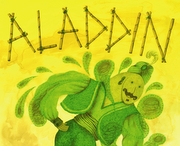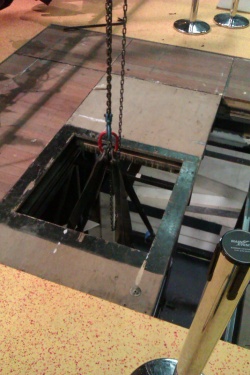Aladdin Panto 2011
| Aladdin Panto 2011 | ||||||||||||||||||
|---|---|---|---|---|---|---|---|---|---|---|---|---|---|---|---|---|---|---|

| ||||||||||||||||||
Aladdin
| ||||||||||||||||||
Cast
Abanazar - Chris Fulton (Max Greig)
Aladdin - Anthony Fagan
Dame - Mark Rowley
Emperor - Martin McBride
Empress - Natalie Songer
Genie - Brian(Christopher)Fisher
Narrator A - Ruby Richardson
Narrator B - Eve Ponsonby
Princess - Amiera Darwish
So Shy - Bobby Stewart
Wishee Washee - Ross Mann
Chorus - Sam Keefe, Cliodhna McCorley, Jimin Suh, Saria Steyl, Alasdair Hankinson, Molly Vevers, Lucy Hollis, Max Greig, Martin
Crew
Production Manager - Sandy McRobbie
Stage Manager - Sarah Wilson
Deputy Stage Manager - Hannah Nicol
Assistant Stage Managers - Amber McClelland, Jack Hirst
Lighting Designer - Alexander Ridgers
Set Designer - Robin Peebles
Sound Designer - Jonathan Towers
Production Electrician - Fraser Walker
Deputy Production Electician - Melissa MacDonald
Technical Stage Manager - Fiona Nisbet
Deputy TSM - Rebecca Coull
Lighting Operator - Jade Beatson
Sound Operator - Jonathan Towers
LX Crew - Michael Parkin
Technical Crew - Neil Foulis, Graeme Brown, Kathryn Douglas, Ashley Kerray, Christopher McIntyre, Jane Paterson, Ben Terry, Natalie Wilson, Andrew McCabe
Set

The set for Aladdin consisted of large set pieces, a lot of flying pieces and cloths. The set was mainly flying pieces, with the peking palace scene required 8 bars for the one scene (not including the reveal gauze and black).
Cloths

Cloths that were used for a number of scenes and scene changes were the US cyc, the starcloth used as a full black (and as a starcloth), and a full black for the demon cave.
The starcloth was mainly used for the flying carpet scene, so give it a romantic magical feeling. A slit needed put in the middle so that the flying carpet mechanism could operate through it.
Four other cloths were used as part of the cave scene; three cut border cloths and one that had a lamp shape cut out of it, for the actors to enter the cave.
The DS and MS cave cloths both had kabukis also attached to them, to transform the cave into a bollywood scene. An US hemp bar was also flown in to cover the US cave cloth.
Noodle Box

Here is a link to a picture of the Noodle Box; it was one of the more difficult pieces of set to move around. It was a truck shaped like a noodle box, with doors that opened and folded up on either side of the truck. A counter was inside the noodle box, which moved forward so that the actors could get behind it. It was the doors that made it difficult to move. A locating bolt was put on each door to help keep them closed, but because of the angle of them, it was a four person move to keep the doors closed.
The counter of the noodle box had a crew member underneath it to pass the actors props. As it was the chorus moving the noodle box on, and it was a fast move I wanted to make it as easy as possible, so having Jack inside was a great help. A cabin hook was put on to the inside of the truck, so once Jack was in it he could close the doors, and open once the truck was set.
Demon Cave
Here is a link to a picture of the Demon Cave (This was taken at the dress, so unfortunately the demon head wasn't working properly)
The demon cave was the second hardest piece of set to move around, as it would only fit in the scene dock with the wings open. This caused a lot of problems the first time we tried to move it offstage. The wings and head were made from a very strong foam as they needed to be lifted during the show, but will still very delicate.
During the show, the wings opened up, and then the head, with two glowing eyes (birdies), would lift up after. The wings were lifted with ropes that could cleat off on the back of the cave. One end was attached to a screweye in the middle of each wing, but due to the angle that the rope needed pulled, the crew members needed to practically be in the stage-wings, so cleating off wasn't possible during the show. The head was slightly more difficult and required to crew members. One to push the head slightly from the inside with a push stick, and another behind the cave with a rope to pull it upright.
Pyramid

The pyramid was the largest piece of set during the second act, taking up half of the scene dock. It had a solid wall with a door on one side, and the other three were gauze, with the US wall being in two pieces that could slide open. During the show, 3 crew members needed to push it, unseen, DS, and disappear down a trap behind it. Cast members and crew would then go up and down the trap on their cues, finally finishing with the baddie in the pyramid and having it spun by the cast to reveal him.
A picture of the Pyramid during the show
Technical Challenges
Genie Trap
The first thing that was done as part of the panto fit up was to lower the genie trap into place. The first that needed done was to find where the center point of the genie trap slider would be on stage, and make a bridal on the grid above this point. We made this using beam clamps and clutch chains. A shackle was then attached to the hook of the chain hoist and a rope dropped down to lift it up and attach to the point on the bridal.

Four slings were wrapped around the lid of the genie trap as this needed to be lifted on top of the genie trap mechanism and bolted on before it was lowered into the pit.

Once the lid was bolted on, ropes were attached to the genie trap to help guide it and the chain hoist (operated from the tallescope) was used to lift the genie trap off the ground slightly. On the first attempt at lowering it down, only one piece of staging was removed, which at the time seemed enough, but whilst lowering it we found that the trap had to be moved up and down stage to fit in; so the genie trap was lifted out again and another piece was taken out.

Just before getting it into its final position, packers needed placed between the beams in the stage and the trap to make it level with the stage. In the pit, a piece of 8by4 steel deck was placed underneath it with small screw jacks, to be able to change the height of the legs so the genie trap wasn't just floating in the pit.

Operating Genie Trap
Flying Carpet
The flying carpet mechanism was a collaboration between the production manager and the workshop tutors, who came up with something that had the 'magical' effect that the director was looking for. Due to the budget for the carpet being cut, the process went through quite a few different ideas, from turning

This is a basic model, that was made before the steel was bought, to make sure that the idea would work once built.
An awesome picture of the Flying Carpet during the show
Kabuki Drop
Glitter Drop


The glitter drop that was used for Aladdin is a gradual one, spread over 1.5m. The glitter drop was made by using a piece of black cloth with slits, 3 small pulleys, 2 pieces of timber( the same width as the piece of cloth), enough black rope to go the SR end of the bar, reach the ground, and a separate piece to make a bridal. The size of the piece of black cloth should be as wide as you want to glitter drop to be. So if the width is 2m, the glitter will spread over 2m. The length of the cloth should be enough for the glitter to sit in and not fall, but we very close the the slits.
First, the black cloth had slits all along one have put into it, to make gaps for the glitter to fall out, and a piece of timber was stapled to each end to make it sturdy. I was lucky with the glitter drop that it was on the same bar as one of the kabukis, so I had 2 bars available to attach it onto. It is possible to do on one bar, but it would be messy, and the timber pieces would catch on each other a lot. The caught quite a lot even when we had two bars, so a small piece of scaff was attached to the top bar to move the pulley further out.
The timber on the slit side was then attached with cable ties onto the bottom bar and a pulley was attached to the center of the top bar. Orignally it was the other way round, but we soon realised that the slits would be on the lower side, and there was no way to keep the rope under tension when the bar was flown out. A bridal was then made for the other piece of timber, the long piece of rope attached and put through the pulley. Another pulley was attached to the end of the bar (with a scaff foot to stop it sliding off) to keep the rope in place.
At first this was operated from the fly floor, but it ended up being too temperamental and kept breaking, and the rope was left to hang, and operated from the ground like the kabukis.
Trap Door
About 5m US, a walk-down trap door was put in place to be used behind the pyramid. During the scene, various characters (and crew) use the trap to enter through the pyramid, and to exit through the pyramid and 'disappear'. The treads were originally made for Dracula, but can be used for any trap door position on the stage.




